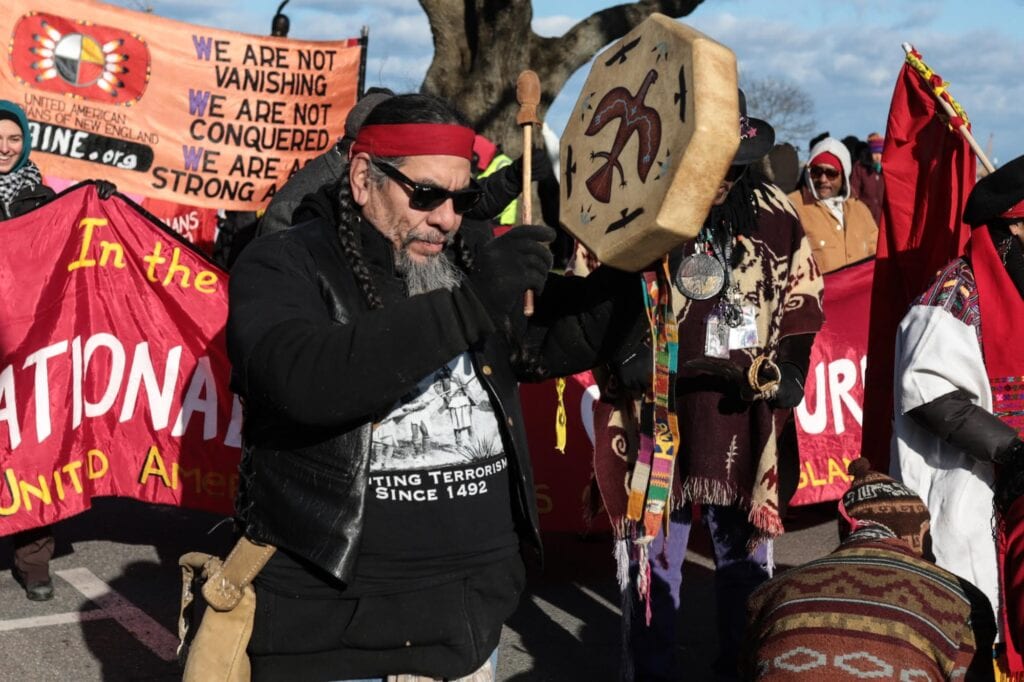By Joseph Nevins, co-author of A People’s Guide to Greater Boston
Most people in the United States will celebrate Thanksgiving this week. Meanwhile, many Native Americans and their supporters will observe a “Day of Mourning.” These conflicting holidays are at the center of the ongoing struggle over the country we call the United States – how it came to be, and what it will become.
Like Thanksgiving, the Day of Mourning has its origins in Plymouth, Massachusetts, or “America’s Hometown” as the heavily-touristed town calls itself. In the entry below from A People’s Guide the Greater Boston, my co-authors, Suren Moodliar and Eleni Macrakis, and I tell a story of Cole’s Hill in Plymouth, where the first Day of Mourning took place and where indigenous activists and allies continue to gather each year on the fourth Thursday of November. Cole’s Hill is one of many sites that make up the book’s “Native Greater Boston tour.” The tour extends from the cities of Haverhill and Lowell, north of Boston, to sites in Boston proper and on the South Shore of Massachusetts, where Plymouth is located.
The following passage is an excerpt from The People’s Guide to Greater Boston
Cole’s Hill
In 1970, for the 350th anniversary of the 1620 arrival of English settlers in Plymouth, the Commonwealth of Massachusetts invited Frank James, a leader of the Aquinnah Wampanoag nation, to address that year’s Thanksgiving celebration. Also known as Wamsutta, James prepared a speech and submitted it to the feast’s organizers. On reading the text, the organizers presented James with an ultimatum: Read a radically revised speech written by the organizers or the invitation would be retracted. James chose his own words.
“We forfeited our country. Our lands have fallen into the hands of the aggressor. We have allowed the white man to keep us on our knees. What has happened cannot be changed, but today we must work towards a more humane America, a more Indian America, where men and nature once again are important; where the Indian values of honor, truth, and brotherhood prevail.”
—Frank James, 1970
On the appointed day, James delivered his original speech before a gathering of hundreds of indigenous people on Cole’s Hill, inaugurating the first annual Day of Mourning. He did so in the shadow of a statue depicting the 1600s Wampanoag sachem Massasoit and directly across from the fabled Plymouth Rock. In his speech, reflecting the period’s national reawakening of Indian pride and militancy, James reviewed the history of indigenous-settler relations. Noting that the hospitality exemplified by the first “thanksgiving” dinner of 1621 was to be “the beginning of the end,” he observed that “before 50 years were to pass, the Wampanoag would no longer be a free people.” In an aligned set of actions earlier that day, Russell Means and Dennis Banks, prominent national leaders of the American Indian Movement, led protestors to briefly take over the Mayflower II site, cover Plymouth Rock with sand, and disrupt the town-sponsored Thanksgiving parade.

Every year since, the United American Indians of New England have rallied at noon on the third Thursday of November on Cole’s Hill before marching through Plymouth Village Historical District and hosting a potluck lunch at the nearby First Parish Plymouth Church. Adding historical import to the meal is the fact that the church is built on the site of the original Plymouth Plantation and fort (built in 1621). Today the rally draws indigenous activists and allies from all over the Americas.

Cole’s Hill overlooks Plymouth Harbor, home to the Mayflower II, a replica of the original Pilgrim vessel. It also features a town-sponsored plaque with a tersely worded statement explaining the significance of the National Day of Mourning as a “protest of the racism and oppression which Native Americans continue to experience.”
—Massasoit, circa 1630s
“What is this you call property? It cannot be the Earth for the land is our Mother nourishing all her children, beasts, birds, fish, and all men. The woods, the streams, everything on it belong to everybody and is for the use of all. How can one man say it belongs to him?”

